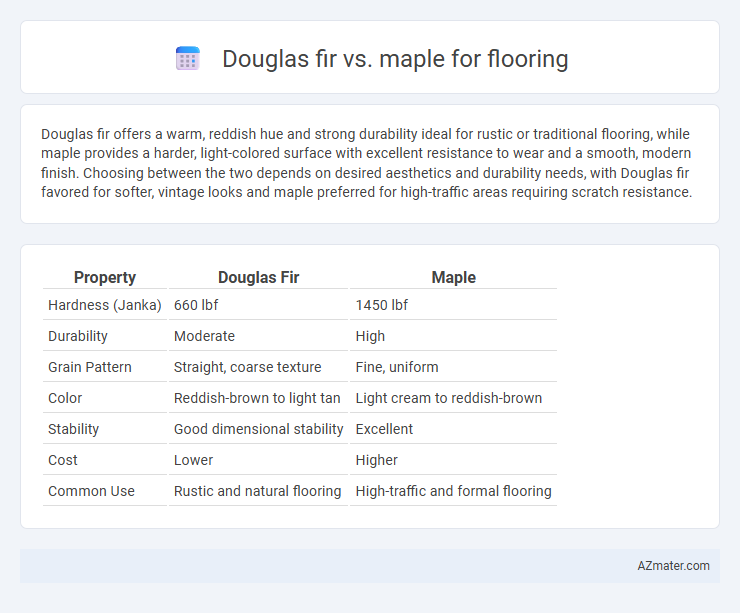Douglas fir offers a warm, reddish hue and strong durability ideal for rustic or traditional flooring, while maple provides a harder, light-colored surface with excellent resistance to wear and a smooth, modern finish. Choosing between the two depends on desired aesthetics and durability needs, with Douglas fir favored for softer, vintage looks and maple preferred for high-traffic areas requiring scratch resistance.
Table of Comparison
| Property | Douglas Fir | Maple |
|---|---|---|
| Hardness (Janka) | 660 lbf | 1450 lbf |
| Durability | Moderate | High |
| Grain Pattern | Straight, coarse texture | Fine, uniform |
| Color | Reddish-brown to light tan | Light cream to reddish-brown |
| Stability | Good dimensional stability | Excellent |
| Cost | Lower | Higher |
| Common Use | Rustic and natural flooring | High-traffic and formal flooring |
Introduction to Douglas Fir and Maple Flooring
Douglas fir flooring offers a durable, aesthetically pleasing option with warm reddish-brown tones and distinct grain patterns, making it ideal for both rustic and modern interiors. Maple flooring, known for its hardness and fine, consistent grain, provides a smooth, lighter appearance that brightens spaces and withstands heavy foot traffic. Both woods present unique benefits in hardness and visual appeal, influencing durability and style choices for residential and commercial flooring projects.
Wood Characteristics: Douglas Fir vs Maple
Douglas fir flooring features a warm reddish-brown hue with prominent grain patterns and a Janka hardness rating of around 660, making it moderately durable and slightly softer underfoot. Maple flooring, on the other hand, is prized for its light creamy color, smooth grain, and a significantly higher Janka hardness rating of approximately 1450, providing excellent resistance to wear and dents. The contrasting wood characteristics make Douglas fir suitable for rustic or natural interiors, while maple is preferred for high-traffic areas requiring robust and long-lasting flooring.
Appearance and Grain Patterns
Douglas fir flooring features a warm, reddish-brown hue with prominent, straight grain patterns that create a rustic and natural aesthetic. Maple flooring offers a lighter, creamy color with subtle, fine grain patterns that provide a smooth and uniform look, often preferred for modern or contemporary interiors. The contrasting grain textures and color tones between Douglas fir and maple allow homeowners to choose flooring that best complements their design style and desired ambiance.
Hardness and Durability Comparison
Douglas fir flooring offers a Janka hardness rating of approximately 660, making it softer than maple, which rates around 1450 on the same scale. This significant difference means maple provides superior resistance to dents, scratches, and wear, ideal for high-traffic areas. Durability in maple floors typically exceeds that of Douglas fir, ensuring longer-lasting performance and better maintaining appearance under heavy use.
Color Variations and Aging Over Time
Douglas fir flooring showcases warm, reddish-brown hues with distinct tight grain patterns that deepen into richer amber tones as it ages, enhancing its natural rustic appeal. Maple flooring offers a lighter palette ranging from creamy white to light reddish-brown, maintaining a smooth and consistent grain that subtly darkens and gains warmth over time. Both woods develop unique patinas with use, but Douglas fir tends to exhibit more pronounced color shifts, while maple ages with a more uniform, gentle darkening.
Installation Considerations
Douglas fir flooring offers easier installation due to its softer texture, which allows for simpler nailing and cutting compared to harder Maple. Maple's density requires specialized tools and more precise handling to avoid splitting and ensure proper fitting, making installation more labor-intensive. Selecting Douglas fir can reduce labor costs and installation time, while Maple demands skilled craftsmanship for a durable and flawless finish.
Maintenance and Care Requirements
Douglas fir flooring requires regular sealing and occasional refinishing to protect its softer wood from dents and scratches, demanding moderate maintenance to preserve its appearance. Maple flooring, known for its hardness and resistance to wear, tends to need less frequent refinishing but requires consistent cleaning to prevent surface damage and maintain its smooth finish. Both wood types benefit from humidity control and the use of protective pads to extend floor life and retain aesthetic appeal.
Cost and Value Analysis
Douglas fir flooring generally costs between $3 to $5 per square foot, offering an affordable option with good durability and a warm, reddish hue that adds value to mid-range homes. Maple flooring, priced around $4 to $7 per square foot, provides a harder surface with superior scratch resistance, making it ideal for high-traffic areas and long-term investment. Considering resale value, maple floors tend to increase home equity more significantly due to their modern aesthetic and durability, though Douglas fir presents a cost-effective choice with classic appeal.
Environmental Impact and Sustainability
Douglas fir flooring offers a lower environmental impact due to its rapid growth rate and wide availability, making it a more sustainable choice compared to maple. Maple trees grow more slowly and require more resources to cultivate, often resulting in less eco-friendly harvesting practices. Choosing Douglas fir supports sustainable forestry management and reduces the carbon footprint associated with flooring materials.
Best Applications for Douglas Fir and Maple Flooring
Douglas fir flooring excels in high-traffic areas due to its exceptional durability and resistance to wear, making it ideal for entryways, hallways, and commercial spaces. Maple flooring offers a smooth, fine grain and hardness that suits residential areas, especially kitchens and living rooms where scratch resistance and ease of maintenance are priorities. Both woods provide long-lasting performance, but Douglas fir's rustic appearance fits traditional or rustic interiors, while maple's light, uniform texture complements modern and contemporary designs.

Infographic: Douglas fir vs Maple for Flooring
 azmater.com
azmater.com